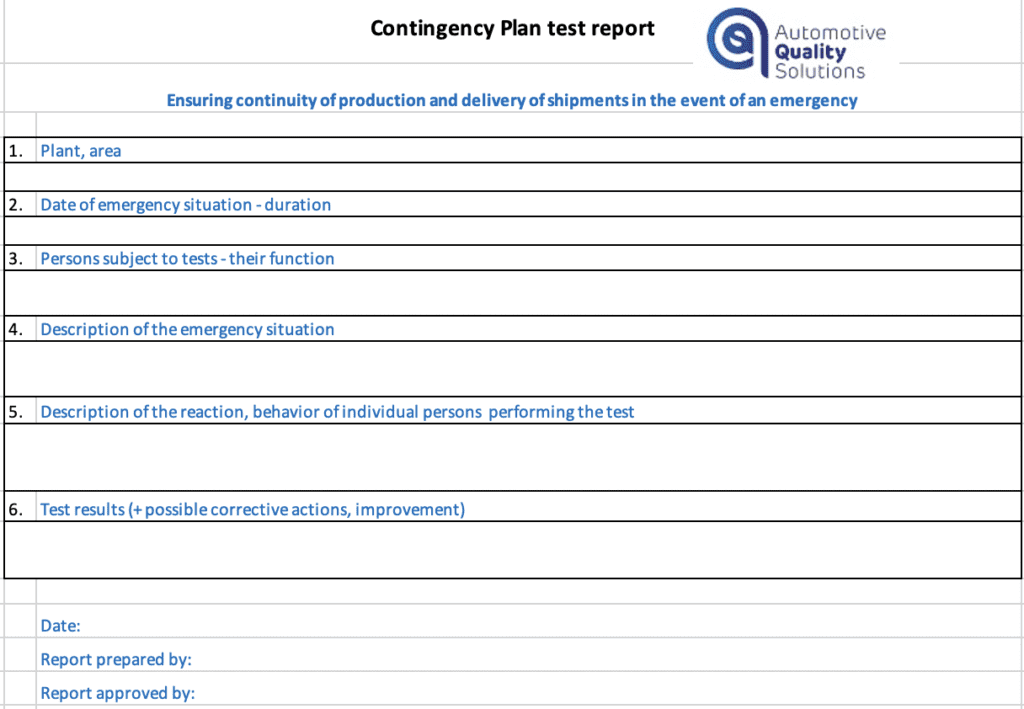The automotive industry is one of the most dynamic and demanding areas, where risk management and ensuring operational continuity play a key role.
Contingency plans, as defined in the IATF requirements in point 6.1.2.3, are a response to these needs. Their purpose is to secure production processes and ensure continuity of supplies in the event of unforeseen situations.
When it comes to emergency planning in accordance with the IATF standard, the first step involves a thorough assessment of internal and external risks for all manufacturing processes and essential equipment.
Organizations must identify risk factors such as equipment or tools damage, interruptions in deliveries, natural disasters, fires, disruptions in media supplies, labor shortages, and disruptions in infrastructure. An additional requirement related to the development and implementation of adequate training and awareness of employees can also be found in the Sanctioned Interpretations.
As illustrated, all scenarios emphasize focusing on the most critical areas and developing appropriate contingency plans. This activity can be further developed during the definition of the risk and opportunity analysis, which is described in a separate article.
Contingency Plans in relation to IATF requirements
The next step is to define contingency plans appropriate to the identified risks and potential impact on the client. The IATF standard requires that they contain the following strategies for action in the event of emergencies:
– Procedures
– Defined responsibilities
– Supply continuity plans
Notification and communication
An important aspect of contingency plans is the appropriate notification of customers and other stakeholders when emergencies occur. Remember to take into account their scale and expected duration in communication.
Organizations should have notification procedures in place that allow for prompt and effective communication with customers. Transparency in communication allows customers to prepare properly and minimizes uncertainty.
In addition, it is worth analyzing the Customer Specific Requirements in this area. At the moment (May 23, 2023),
Contingency Plans: Testing, Review and Documentation – Key steps to ensure effectiveness
Another important element is regular testing of the effectiveness of contingency plans. This involves simulating emergencies to ensure their effectiveness and adaptation to changing conditions.
One practical solution is to implement a form containing the following sections:
– What (Emergency description)?
– Where?
– When?
– Who is responsible for the area/activities?
– Description of the reaction and conduct of the individuals involved
– Results/decision to escalate to stakeholders
As you can see, the first four elements fit into the 5W2H tool used in problem solving.

Fig. 1. Contingency Plans Test Report Form – Download the document using the link provided at the end of the article.
Additionally, the IATF standard requires contingency plans to be reviewed annually with the participation of an interdisciplinary team, including top management. This activity is typically carried out during a management review.
During these meetings, it’s essential to discuss the following key elements:
Functions, not names: This ensures procedures don’t need frequent updates due to organizational changes.
Current contact information: Ensure accurate phone numbers to reach the appropriate personnel.
Reaction time to situations: Establish appropriate response times based on the scale of the situation.
Up-to-date links in company procedures: Avoid including network drive links in procedures due to frequent migrations of information.
Proper documentation of all changes and revisions, including authorization responsibilities.
Contingency Plans – summary
The implementation of contingency plans in compliance with the requirements of the IATF 16949:2016 standard enables organizations to effectively manage risks, promptly respond to emergency situations, and uphold the high quality of deliveries, thereby ensuring customer satisfaction.
These plans serve as preventive measures, preparing organizations for unforeseen circumstances, and are integral to achieving operational excellence in the automotive industry.
You can download an editable Excel form for free on the Free Quality Tools
Documents name:
– Contingency Plan Report (IATF 6.1.2.3) – Excel template
– Contingency Plans – EHS and Infrastructure example – Excel template
Dariusz Kowalczyk
Bibliography:
1. IATF Automotive Quality Management System Standard – 1st edition, 1 October 2016


